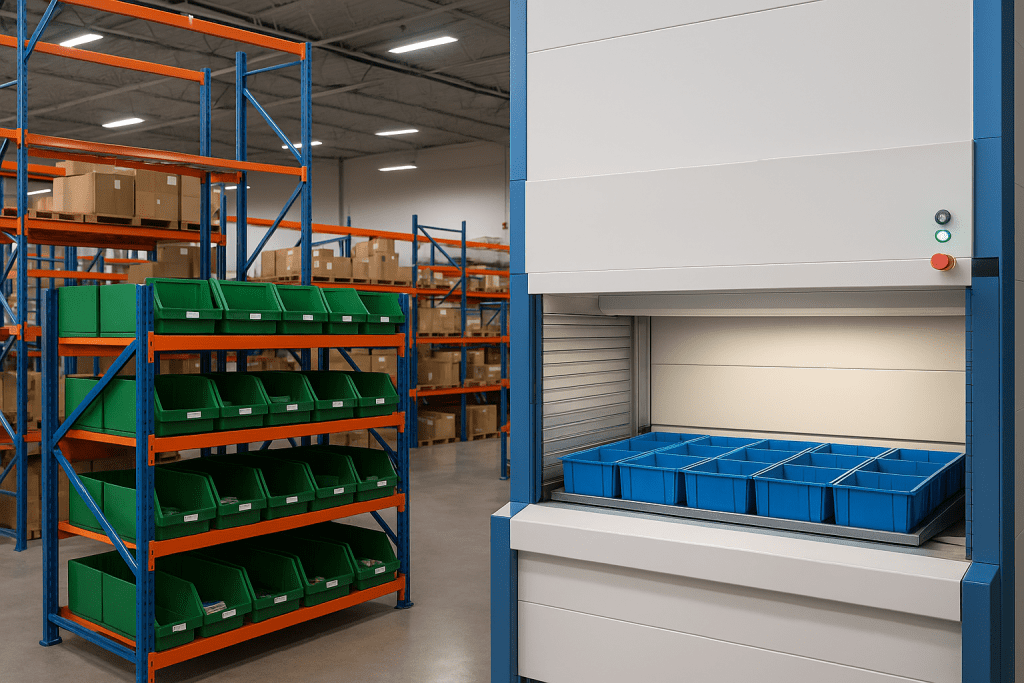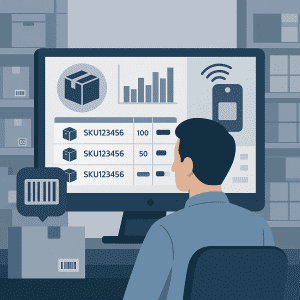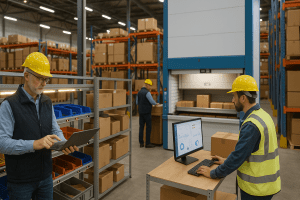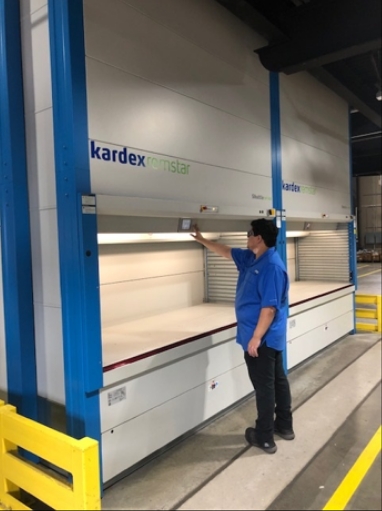Every warehouse starts the same way — a few rows of shelving, some labeled bins, and a handful of operators who know where everything lives. But as orders grow and space runs out, the cracks begin to show.
That’s when warehouse inventory management shifts from a manual routine to a strategic system that determines accuracy, throughput, and profitability.
This guide explores the evolution from basic bin shelving to goods-to-person (G2P) automation — how each stage improves productivity, and when it’s time to take the next step.
1. The Foundation: Manual Bin Shelving
Bin shelving has always been the go-to entry point for small and mid-sized operations. It’s inexpensive, flexible, and easy to reconfigure. Operators walk the aisles, scan barcodes or checklists, and pick one order line at a time.
It works — until it doesn’t.
As order volumes rise, operators spend more time walking than picking. Even a modest facility can rack up miles per day per worker. And that walking doesn’t create value — it’s wasted motion that cuts into labor productivity.
Common pain points at this stage include:
Low pick density (60–100 lines per hour on average).
High travel time, which can consume half a shift.
Inaccurate inventory counts due to manual updates.
Underutilized space, especially vertically.
The result? Operators move more, pick less, and storage expands horizontally instead of vertically.
That’s when digital tracking and semi-automation start to deliver measurable ROI.
If you’re still running on clipboards and floor markings, start with an organizational baseline like the one outlined in Warehouse Organization Best Practices: From Pallets to Parts.
2. Building the Digital Core
Before you can automate, you need visibility. Data accuracy is the foundation of automation success.
A reliable Inventory Management System connects every SKU, bin, and transaction in real time — replacing the guesswork of manual spreadsheets.
With digital tracking in place, you can:
Record every movement automatically through barcode or RFID.
Maintain perpetual inventory counts.
Schedule cycle counts without halting production.
Set min/max reorder alerts to prevent shortages or overstock.
Access live dashboards that show pick rates, accuracy, and utilization.
This visibility not only streamlines your current process but also prepares your data to connect with automation later — whether that’s pick-to-light modules or a full vertical lift system.
The transition often begins by digitizing just one area, such as your fast-moving SKUs or MRO parts room. Once your data is clean and consistent, layering automation becomes seamless.
3. Step One Toward Automation: Pick-to-Light Systems
When a warehouse hits its labor or travel-time ceiling, Light-Directed Picking Systems are the simplest and most effective way to boost throughput.
These systems use LED lights mounted at bin locations to direct operators where to go and how many units to pick. Once a pick is confirmed, the next light activates — eliminating the need for paper, handheld scanners, or guesswork.
Advantages of Pick-to-Light
2–3× higher lines per hour compared to paper-based picking.
Accuracy above 99.8%.
Minimal training time, allowing new hires to be productive on day one.
Scalable modular design—easy to expand for peak seasons or new SKUs.
By cutting decision time and improving visibility, pick-to-light bridges the gap between manual shelving and fully automated systems. For many facilities, it delivers enough ROI to fund the next phase of automation.
4. The Turning Point: Goods-to-Person Systems
Once labor costs climb or available space runs out, the next leap in warehouse inventory management is automation that brings products directly to people instead of the other way around.
In a goods-to-person (G2P) workflow, automated equipment retrieves totes, trays, or parts and delivers them to ergonomic workstations. The operator stays in place, picking and packing without unnecessary walking or searching.
At Vertical Storage USA, these systems are powered by technologies such as Vertical Lift Modules (VLMs) and Automated Storage and Retrieval Systems (AS/RS) — both designed to condense inventory vertically and eliminate wasted movement.
G2P Performance Benchmarks
| Metric | Manual Shelving | Pick-to-Light | G2P (VLM or AS/RS) |
|---|---|---|---|
| Lines per Hour | 80–100 | 200–300 | 400–700+ |
| Travel Time per Pick | 45 sec | 10–20 sec | < 5 sec |
| Space Utilization | 30–40% | 50% | 80–90% |
| Accuracy | 98% | 99.8% | 99.99% |
These improvements translate directly into labor savings, faster order fulfillment, and the ability to scale without expanding your building.
5. How VLMs Transform Inventory Management
A Vertical Lift Module is a high-density automated storage system that uses a central elevator to move trays between access points and internal storage columns.
When an operator requests a part, the VLM automatically retrieves the correct tray and presents it at an ergonomic height. This reduces strain, eliminates ladder climbing, and keeps operators in one efficient workspace.
Key advantages:
Up to 90% space savings compared to shelving.
Improved order accuracy thanks to controlled access windows.
Real-time inventory updates with every transaction.
Better ergonomics and reduced injury risk.
Easy WMS integration for data-driven visibility.
VLMs are especially valuable in industries with high part variety or traceability requirements — aerospace, medical device, manufacturing, and MRO facilities all see rapid payback from vertical storage.
For a deeper overview of system types, visit the Vertical Lift Modules page.
6. Smarter Slotting Through Data
Once automation begins, your system generates data on every transaction — pick times, dwell times, part velocity, and operator performance.
With this data, you can enable dynamic slotting: automatically reassigning storage locations based on usage. High-volume SKUs move closer to the access window, while slower items migrate higher or deeper into the VLM.
This continuous optimization helps maintain balanced throughput without manual rearranging — and it’s one of the key differentiators between traditional inventory systems and intelligent automation.
7. Phased Modernization: The Hybrid Approach
Automation isn’t an all-or-nothing investment. Many successful warehouses take a hybrid approach that scales over time:
Digitize inventory data with an integrated WMS.
Deploy pick-to-light zones in the heaviest SKU areas.
Install one or two VLMs for high-value or slow-moving items.
Integrate systems under one software platform for G2P automation.
This incremental process reduces upfront costs, minimizes disruption, and allows teams to adapt. Each step produces measurable ROI before the next investment.
8. Measuring ROI: When Automation Becomes Essential
Warehouse leaders often ask: When do automation investments make sense?
Here are some clear triggers:
Labor costs consume more than 40% of operational expenses.
SKU count exceeds 3,000 or daily orders surpass 500.
Space expansion would require new construction or leasing.
Order accuracy goals are above 99.5%.
Hiring challenges make manual scaling unsustainable.
In these cases, automation typically pays for itself in 18–36 months.
For an estimate based on your own data, try the ROI Calculator.
9. Workforce Efficiency and Retention
One of the most overlooked benefits of automation is its impact on people.
VLMs and G2P systems eliminate bending, reaching, and ladder climbing — significantly reducing fatigue and injuries. Pickers spend more time handling product and less time walking or searching. That means lower turnover and easier training for new staff.
In today’s labor market, improving ergonomics isn’t just a perk — it’s a competitive advantage.
10. The Future of Warehouse Inventory Management
The next evolution of warehouse management blends automation, robotics, and analytics. Facilities are beginning to integrate storage robots, autonomous vehicles, and cloud-based monitoring that predicts maintenance before downtime occurs.
At the same time, AI-driven insights will continue optimizing slotting, forecasting demand, and balancing workloads across systems.
For operators, the mission remains the same: store smarter, pick faster, and use every cubic inch efficiently.
Frequently Asked Questions About Warehouse Inventory Management
1. What is warehouse inventory management?
Warehouse inventory management refers to the process of tracking, organizing, and optimizing how products move through a facility — from receiving to storage to order fulfillment. A strong system ensures accurate counts, reduces travel time, and improves throughput by aligning labor, layout, and automation.
2. When should a warehouse upgrade from manual shelving to automation?
If your team spends more time walking than picking, struggles to maintain accuracy, or has run out of space for expansion, it’s time to consider automation. Many warehouses start small with light-directed picking systems or a single Vertical Lift Module (VLM) to handle slow-moving or high-value inventory before scaling up.
3. What is a goods-to-person (G2P) system?
A G2P system uses automated equipment to bring stored items directly to a stationary operator. Instead of walking aisles, the worker stays in one place while a VLM or AS/RS system retrieves and delivers the right tray or tote. This approach minimizes travel, boosts accuracy, and dramatically increases lines picked per hour.
4. How does automation improve inventory accuracy?
Automated systems integrate directly with your inventory management software to record every transaction in real time. Because each pick, putaway, or cycle count is logged automatically, inventory discrepancies are reduced and audits become faster and more reliable.
5. Can a warehouse add automation in stages?
Absolutely. Many facilities take a phased or hybrid approach, beginning with digital tracking, then implementing pick-to-light systems, followed by a few VLMs for high-density storage. Each phase builds measurable ROI and allows your team to adapt to the new workflow before scaling further.
6. How much space can vertical automation save?
On average, VLMs and automated storage systems recover up to 90% of floor space previously used by static shelving. By storing vertically and accessing trays automatically, warehouses can expand capacity without adding square footage.
Ready to See It in Action?
Every warehouse can evolve from manual shelving to goods-to-person automation — it just takes a plan.
If you’re ready to explore what automation can do for your space, see a G2P demo plan or request a complimentary layout analysis from Vertical Storage USA.
We’ll help you visualize the ROI of integrating VLMs, light-directed picking, or AS/RS technology into your existing operation.





